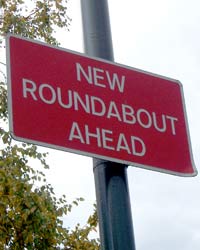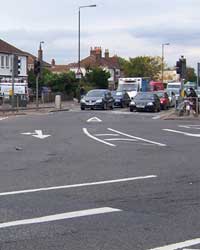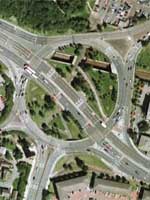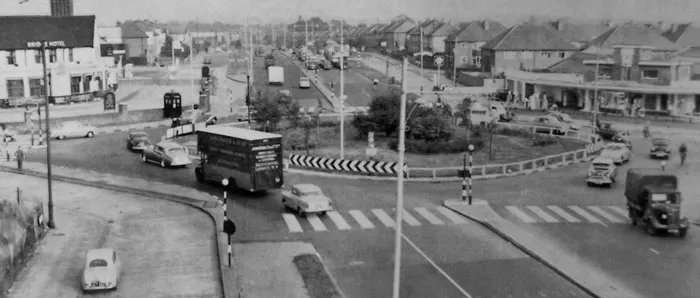
More and more, our roundabouts aren't just roundabouts. They have complex schemes of white lines and traffic lights and signs and symbols and cut-throughs and turn lanes and any number of other elaborate appendages. Some of them don't feel like roundabouts at all any more, which may induce feelings of loss and regret in the more passionate roundabout fan and confusion in the average motorist.
Of greater concern, perhaps, are the roundabouts being cleared away for conversion to traffic light junctions. What is this madness about? Does it mean - horror of horrors - we may be approaching the end of roundabouts?
Lines, arrows and lights
In the recent past - perhaps the last twenty years or so, really - there have been developments in what you might call roundabout treatments: the way that your finished roundabout is decorated and furnished to squeeze every last drop of capacity from it.
If your roundabout is locking up, or if it has unbalanced flows that cause delays on some approaches because there aren't enough opportunities to enter the junction, you might want to signalise it. The first experiments in signalisation were carried out in the late 1950s by the Road Research Laboratory, and didn't actually signalise the roundabout itself. Instead they put the signals about fifty yards back from the junction to moderate the amount of traffic approaching on the major road. This caused delays for everyone and didn't fix the roundabout.

Today we put the signals across each entry point, and time them in such a way that major flows around the junction get a green light as they pass around the roundabout itself. They are widely grumbled-about and undeniably controversial, especially when the lights are left on at quiet times, but done properly, it can be the solution to a junction's problems.
Something that sometimes goes hand-in-hand with signals, or can be used on its own, is the introduction of spiral markings. Spirals are designed to iron out lane-changing and make the best possible use of roadspace by allocating a path for every flow of traffic so that people cross over each other less often. The markings spiral out from the centre of the island and eventually deposit the motorist on their exit, and a properly spiralled roundabout should feel completely natural, leaving the motorist wondering why all roundabouts can't be so wonderful and calming.
Just like roundabout geometry, signalising and spiralising a roundabout can succeed or fail depending on the skill of the designer. There are good ones and bad ones; spirals that flow and spirals that seem to work against you. Very small roundabouts, in particular, are rarely suitable for these treatments. The junction of the A216 and A217 in Mitcham, South London (shown left), is a case in point: it's so small that the signals just let one arm of the junction go at once, and the spiral markings don't spiral, which means the junction never functions as a roundabout at all - just a circular obstacle to turning right.
Food, glorious food

The most recent developments all seem to be named after types of food. They work on the principle that if one dominant flow through the junction is causing problems, you should give it a dedicated path through the roundabout.
The simplest of these is the Hamburger: it ploughs a two-way road through the central island, with all the other movements happening around the outside. The junction at the end of the M602 is like this (shown right; click to enlarge). It requires traffic signals for all but the quietest cases, due to all the additional cross-traffic it introduces, but it does increase capacity significantly in the right location.
That must be why some bright spark dreamed up a way of doing the same trick twice, creating the Hot Cross Bun. Instead of one road over the middle, you now have two, that both cross the central island and also cross each other at a crossroads inside the roundabout. Straight-on traffic goes through the middle and turning traffic plods around the outside on the remaining fragments of roundabout.

Elements of this technique are starting to turn up on their own, and the idea of a one-way path through the middle of a roundabout - usually curving to cater for large right-turn flows - has been jokingly called a Bananabout.
It's not called that at all - that would be silly, and would cause civil servants embarassment, which is why official names are as straight-faced and sensible as "Hot Cross Bun". No, it is more properly referred to as an unhooked right turn. Again, it has to be signalised, but it can really sort things out for the rest of a roundabout if you just make some more space for that one problematic and overloaded flow of traffic.
The end?

In recent years there seems to have been something of a trend to do away with big roundabouts and replace them with traffic signals: the one at the end of the M27 junction 12 spur, the northern end of the A627(M) at Rochdale and the junction of A1 and A199 east of Edinburgh are some high-profile examples. Is this the end for roundabouts? Have traffic lights won?
The flashing disco lights certainly have more advantages these days: they have been freed from the fixed signal cycle of old and can now be computer-controlled, sensitive to traffic flows, spotting and reacting to waiting traffic, linked to other nearby junctions for more effective management of traffic across a whole city, and more. It's also easier to design in facilities for pedestrians and cyclists, which is a requirement these days.
The truth is that roundabouts are not disappearing. They're just too useful for that. What we are seeing is a shift in where they are applied and why: they are more suitable for out-of-town use, on fast roads where you don't want traffic stopped at a red light and where there aren't many pedestrians. They are great for allowing middle-of-the-road landscaping in a housing estate or retail park. It's true that, correspondingly, we're seeing more traffic signals in built-up areas and fewer roundabouts, because increasingly the lights are proving more adept at the job. But now, as much as ever, it's a case of judging each case on its merits and deciding what is the right type of junction for this location.
The end of roundabouts? Not likely.

Picture credits
- Photograph of experimental signals on Western Avenue taken from National Archives file DSIR 12/181.

